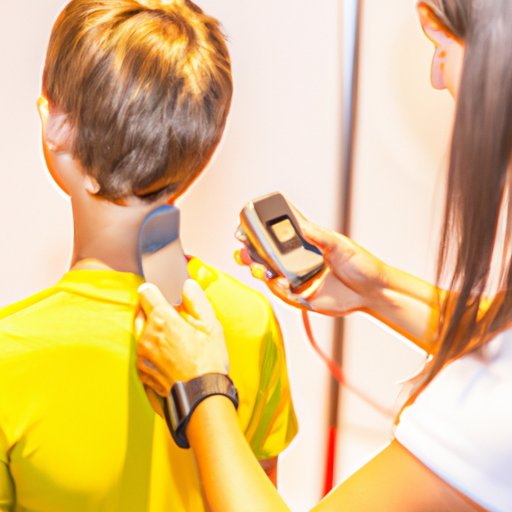I. Introduction
Have you ever wondered why your body weight doesn’t necessarily reflect how healthy you are? That’s because body composition – the ratio of fat and lean mass in your body – is a more accurate predictor of overall health and fitness. In this article, we’ll explore the different methods of measuring body composition and why it’s important to pay attention to it.
II. Methods for Measuring Body Composition
There are several methods for measuring body composition:
A. Skin fold measurements
This involves using calipers to measure the thickness of skinfolds at various points on the body.
B. Bioelectrical impedance analysis
This method sends a small electrical current through the body to measure the resistance of different tissues. It’s often done using a handheld device or scales with built-in electrodes.
C. Dual energy X-ray absorptiometry (DXA)
This is the most accurate method of measuring body composition, using low-dose X-rays to measure bone density, fat mass, and lean mass.
D. Benefits and drawbacks of each method
Skin fold measurements are inexpensive and non-invasive but can vary depending on the skill of the person doing the measurement. Bioelectrical impedance analysis is easy to use and widely available but can be affected by factors such as hydration levels. DXA is the most accurate but also the most expensive and requires specialized equipment.
III. Which Method is Best for You?
The best method for measuring body composition depends on your individual needs and preferences.
A. Comparison and contrast of popular methods
Skin fold measurements and bioelectrical impedance analysis are often used in fitness and medical settings. DXA is generally used for research purposes or by individuals with specific health conditions, such as osteoporosis.
B. Ideal method for different individuals
For those who are just looking for a general idea of their body composition, bioelectrical impedance analysis may be sufficient. Athletes or bodybuilders who require more precise measurements may prefer skin fold measurements or DXA scans.
C. Best method for different fitness levels
Beginners may benefit from using bioelectrical impedance analysis to track progress over time. Advanced fitness enthusiasts may prefer skin fold measurements or DXA scans to get a more detailed picture of their body composition.
IV. Myths About Measuring Body Composition
There are several myths about measuring body composition that can lead to confusion or misinformation.
A. Common misconceptions
One common myth is that BMI (Body Mass Index) is an accurate measure of body composition. In reality, BMI only takes into account weight and height and doesn’t distinguish between fat and muscle mass. Another myth is that body fat percentage is the most important measure of body composition. While it’s one important factor, it’s also important to consider lean mass and bone density.
B. Data and research to debunk myths
Studies have shown that BMI is not a reliable indicator of individual health. For example, a muscular person may have a high BMI despite having a low body fat percentage. Additionally, research has shown that bone density is an important factor in overall health and fitness, particularly as we age.
V. Optimal Body Composition and Achieving Your Fitness Goals
Optimal body composition varies depending on individual goals and needs.
A. What optimal body composition looks like
Generally, a healthy body composition includes a moderate amount of body fat (between 20-25% for women and 15-20% for men), adequate muscle mass, and good bone density.
B. Using body composition measurements to achieve fitness goals
By tracking changes in body composition over time, you can get a more accurate sense of your progress towards your fitness goals. For example, if you’re trying to lose weight, seeing a decrease in body fat percentage and an increase in lean mass can be a good indication of progress.
VI. Potential Risks
Obsessing over body composition measurements can be harmful to physical and mental health.
A. Negative effects of obsessive behavior
Constantly obsessing over body composition can lead to disordered eating patterns or exercise addiction.
B. Risks of disordered eating
Restrictive diets or excessive exercise can lead to a range of health problems, including nutrient deficiencies, hormonal imbalances, and even organ damage.
C. Advice on how to avoid these pitfalls
It’s important to focus on overall health and wellbeing rather than a specific number on the scale or an ideal body type. Eating a balanced diet, getting enough rest and exercise, and seeking help from a mental health professional if needed can all help to avoid these potential risks.
VII. Actionable Takeaways
If you’re interested in measuring your body composition, there are several steps you can take:
A. Recommendations for how often to measure body composition
How often you measure your body composition depends on your goals and preferences. If you’re just starting out, it may be helpful to measure every few months to track progress. As you become more advanced, you may want to measure more frequently to fine-tune your results.
B. What to do if your measurements are not within the healthy range
If your measurements indicate that your body composition is not within the healthy range, it’s important to talk to your healthcare provider or a registered dietitian. They can help you design a plan to achieve a healthy body composition and avoid potential health problems.
C. How to use body composition measurements to set fitness goals
Measuring changes in body composition over time can be a good way to track progress towards fitness goals. For example, if your goal is to gain muscle mass, seeing an increase in lean mass over time is a good indication that you’re on the right track.
VIII. Conclusion
Overall, measuring body composition is an important tool for achieving optimal health and fitness. By understanding how to measure it, setting realistic goals, and avoiding potentially harmful practices, you can achieve a healthy and sustainable body composition that supports your overall wellbeing.
